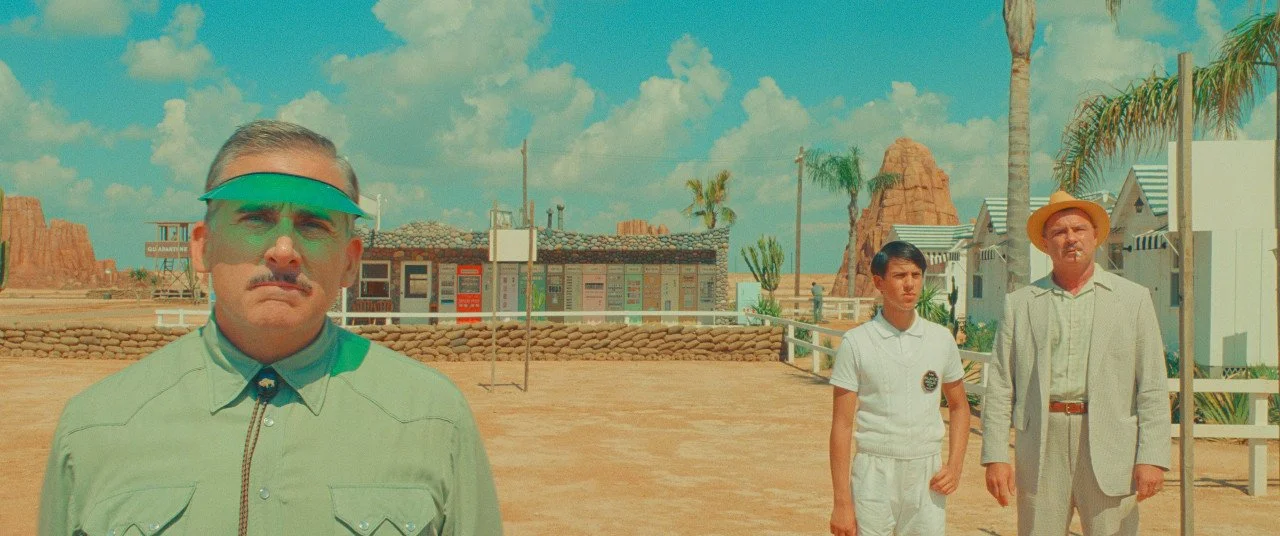Asteroid City: Wes Anderson Does Wes Anderson as Only Wes Anderson Can
By Karen Gordon
Rating: B+
After Asteroid City had its world premiere at the Cannes Film Festival last month, the New York Times ran a story with the headline “Wes Anderson’s Asteroid City: How Wessy Is It?”
It’s a rhetorical question, of course. By this point in time, it would be big news if Anderson made anything un-Wessy. His style is so singular that he really is his own genre.
Over the course of his career — Asteroid City is his 11th feature film — his movies have become increasingly more visually stylized. The tone is slightly artificial but also idiosyncratic, twee, and populated by highly eccentric characters.
Anderson, who regularly collaborates on story and screenplays with Roman Coppola and sometimes actor Jason Schwartzman, has accumulated a repertory of actors, regulars who sometimes star, and sometimes pop up in cameo roles which, for Anderson fans, is as much a delight as a clever story turn.
His visuals are so specific that they’ve recently been turned into memes. Before the recent coronation ceremony of King Charles, memes appeared featuring members of the British royal family posed as if in a Wes Anderson movie, and more recently the characters of the TV series Succession.
If you’re going to see a Wes Anderson movie, then you’re going to spend as much time in his visual universe as in his thematic one. Which brings us to Asteroid City where Anderson does of course, lead with style, and all the Andersonian tropes.
Set in a very Americana 1955, Asteroid City is a story within a story. Bryan Cranston starts us off on a TV set, as the host of a black-and-white TV show. He tells us that there is no such place as Asteroid City and what we're about to see is a new play. He introduces the actors who will play parts in the coming production. And we meet the playwright, Conrad Earp (Edward Norton).
The film then shifts to colour for the ‘play’ itself. Asteroid City is a small town, built around a tourist attraction: a spot in the Nevada desert where a meteor hit, leaving a large impact crater. A piece of the asteroid remains, displayed in a small cage.
Next to the crater is an astronomical observatory. And a field of radio telescopes. The town itself has a population of 87 and consists mostly of a service station run by The Mechanic (Matt Dillon) and a small motel and luncheonette run by The Manager (Steve Carell).
The motel is getting an influx of guests, for an annual event that will take place in the crater as part of “Asteroid Day.” Five science students who have won awards for their inventions will show them off and be presented with the Hickenlooper Scholarship. The awards will be given out by five-star General Grif Gibson (Jeffrey Wright) and scientist Dr. Hickenlooper (Tilda Swinton), who have turned the event into a long weekend of science activities.
Parents and children arrive but most of the action centres around recently widowed war photographer Augie Steenbeck (Schwartzman), who has brought his son, Woodrow (Jack Ryan) — who he calls Brainiac — and three fanciful pre-school young daughters, who amuse themselves by imagining they’re witches and vampires. Augie hopes his father-in-law Stanley Zak (Tom Hanks) will take his daughters to stay with him while he and his son participate in the weekend’s awards events.
The other major player here in Augie’s story is movie star Midge Campbell (Scarlett Johansson), whose daughter Diana (Grace Edwards) is another of the award-winning students.
All plans for the weekend go sideways during a midnight gathering in the crater when a spaceship descends into the crater. An alien lowers himself in and, while the group watches in stunned silence, the alien grabs the rock.
The army locks Asteroid City down, which means everyone is now stuck at the motel for at least a week and can’t communicate with the outside world. The gathering now becomes its own little city, where the science brainiacs hang out together, and the adults get a chance to get to know each other. Music happens, thanks to Montana (Rupert Friend) and his band of musician cowboys. Conversation happens. Romance happens.
There are a lot, and I mean a lot, of moving parts here, between the action in Asteroid City, and the black-and-white world of the play and the actors. Remarkably, Anderson keeps all the balls in the air in a way that feels seamless. But there is a bit of a challenge in what he’s done here.
Just as we're getting to know the various characters and their interactions in the ‘play’ of Asteroid City, Anderson deliberately pulls us out and takes us back to The Host and his black-and-white world. The Host shows us scenes of the playwright, and a theatre class run by the intense Saltzburg Keitel (Willem Dafoe), attended by the actors who we’ve seen in Asteroid City, and the director Schubert Green (Adrien Brody), and his dilemmas, before returning us to ‘the play.’
Going away from Asteroid City, and from colour to black and white and back again, underlines the idea that we're watching a fiction. It should create emotional distance between us and the characters. And yet, in the magical way that Anderson tells stories, it’s easy to forget that the events in Asteroid City aren’t real.
That’s even more remarkable considering how Anderson approaches his material. Shots are carefully composed so that they often look artificial. And that artificiality extends to emotional material and relationships, in which many characters speak in the Andersonian way: detached, crisp and brittle. It’s yet another layer of artificiality, another thing that should prevent us from bonding to any of the characters.
And yet, Anderson is so much in his element and in command of what he does, that all the reminders he gives us in the film that we're not watching real life, all of the things he does that seem designed to pull us out of engagement with the characters, doesn't work that way.
In most of his movies the chop-chop comedy is what’s on the screen, the situations that drive the action are often strange and slightly bizarre, all of which he does in ways that seems aimed at distancing the characters from what would be more ordinary or normal emotional reactions.
This all defines his work as comedy. Yet, the style that seems designed to keep things on the surface often goes deeper. The characters are all longing for something and there’s often a vein of melancholy and empathy that echoes after the film ends.
Even after all the to-ing and fro-ing between colour and black and white, we’re still left with a connection to Augie and his children as they depart Asteroid City and return to their lives. So, the answer to the Times question is yes. Asteroid City is very Wessy. Maybe the most Wessy ever. And thank goodness for that.
Asteroid City. Written and directed by Wes Anderson. Starring Jason Schwartzman, Scarlett Johansson, Tom Hanks, Jeffrey Wright, Tilda Swinton, Bryan Cranston, Edward Norton, Rupert Friend, Adrien Brody, and Liev Schreiber. In theatres June 23.



